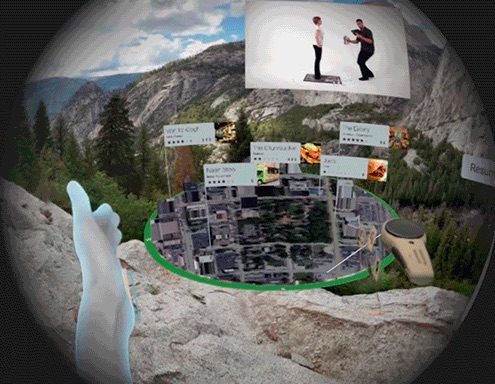

LISTEN TO THE VOICES OF VR PODCAST
Mike says that interaction design is all about looking at the properties of a given technology as well as the properties of humans. The different types of motion tracked controllers versus hand-tracking will dictate the best user interface. For example, if you look the mouse and keyboard model of interaction for a desktop computer then you have two different types of input, and perhaps immersive professional applications will eventually take a similar approach of having one hand-on a 6 degree of freedom controller, and the other hand being tracked with a camera. But having a combination of technologies would dictate the range of interaction design possibilities. Mike had an example of this in one of this videos:
Mike uses his background in filmmaking and motion graphics in order to put together some prototypes and user interface ideas in a couple of popular videos called “VR Interface Design Manifesto” and “VR Interface Design Pre-Visualization Methods”
Mike is able to have some fast iterations by using After Effects and Cinema 4D, but he also advocates translating other ideas from web design such as the design grid. You can still do a lot of paper prototyping of interface ideas, but VR is a medium that has spatial, depth, and lighting considerations and so it’s helpful to see what it actually might look like in VR as well. Mike refers to Alex Chu’s presentation where he suggests using a “greybox prototyping method” by putting in textureless primitives in Unity to quickly test out lighting and spacing layouts.
Mike’s second video had a call to action that he was looking for a job as a VR experience designer, and he’s since taken a job within Google’s VR design department. Based upon the feedback he got on the video, he sees that there’s a huge demand for more designers to get into VR to help experiment, iterate, and figure out the rules for creating the most comfortable interactions.
I asked Mike about projecting the UI onto a sphere, and he said that this feels more comfortable because the UI elements are all equidistant from your eyes and that this helps to avoid the vergence accommodation conflict that can happen with objects being at different distances. Another tip that Mike gave was to look at how we are currently mimicking depth within 2D interactions with drop shadows, and to convert those visual cues into actual depth within VR. He’s also really interested in how to create non-fatiguing interfaces that prevent forcing users from doing too many repetitive motions that could strain muscles.
Mike says that being a filmmaker is like being an experience designer in a 2D medium, and that there’s still a lot to be learned about the language of VR. For example, Oculus Story Studio discovered that the distance of characters from the camera can affect the emotional impact of a scene. And just like any other communications medium, VR is going to have a lot of strengths and weaknesses and these specifics will be more clear as more VR creators experiment with different combination of factors.
Finally, Mike hopes that he can help make VR a socially acceptable way to experience immersive entertainment and education as well as do useful work in the enterprise. Since the recording of this interview, Mike has since taken a job as a VR designer at Google and I hope to see a lot more insights and lessons learned as he continues to iterate and explore his ideas about interaction design with VR.
Become a Patron! Support The Voices of VR Podcast Patreon
Theme music: “Fatality” by Tigoolio



